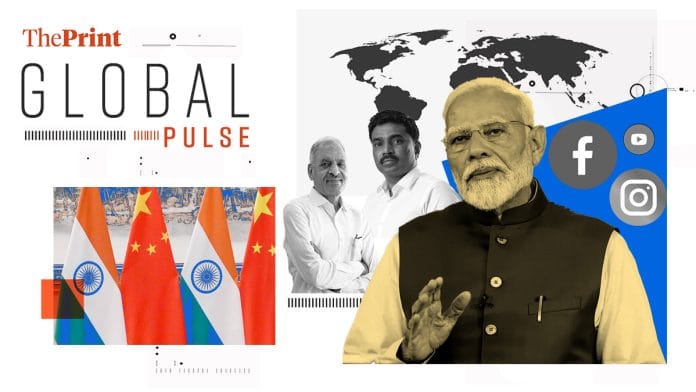New Delhi: A Bloomberg report by Advait Palepu and Pui Gwen Yeung notes that “Modi’s regime is minting billionaires at a brisk pace” and India is experiencing “its version of the Gilded Age”. The Gilded Age refers to the period in the late 1800s when the US saw major economic growth. The Bloomberg report underscores that a combination of the surging economy and the government’s pro-business policies is fostering concentrated pockets of wealth, even as overall inequality widens. It cites data indicating that the number of ultra-high net-worth individuals in India — those with a net worth of $30 million or more — is expected to jump by 50 percent by 2028.
The report also names several lesser-known billionaires, including P.V. Krishna Reddy, Managing Director of Megha Engineering & Infrastructures Ltd with a net worth of $8.3 billion; Satyanarayan Nuwal, Chairman of Solar Industries India Ltd with a net worth of $6.9 billion; Karsanbhai K. Patel, Chairman of Nirma Ltd with a net worth of $6.6 billion; Chandru Raheja, Chairman of K Raheja Corp and Shoppers Stop with a net worth of $3.6 billion; and Acharya Balkrishna, Managing Director of Patanjali Ayurved Ltd with a net worth of $3.8 billion.
China has become India’s largest trading partner, with imports from China rising by 3.24 percent to $101.7 billion and exports to China increasing by 8.7 percent to $16.67 billion. An editorial in the Global Times argues that this growth “underscores the potential for economic and trade cooperation between China and India”, highlighting how the acceleration of India’s manufacturing sector is making their economies more complementary.
The editorial addresses the question of India replacing China as the world’s factory, stating that “India is not in the same segments as China” within global industrial and value chains.
Titled ‘India’s Ambitions Can Foster Complementarity with China’, the piece suggests that Chinese expansion in the Indian market and India’s relaxation of policies to “foster a favourable business environment” can enhance collaboration, and “by leveraging their complementary strengths and exploring opportunities for collaboration, China and India can forge a more stable and prosperous trade relationship”.
Seasoned journalist John Ibbitson in the Globe and Mail addresses the topic of Indian immigration to Canada. In 2021, India accounted for 32 percent of Canada’s new permanent residents (PR). While India has always been in the top three sources of immigrants since 2001, its share grew dramatically in the last decade with over 1 lakh Indian nationals gaining PR in Canada.
In his article, “Understanding the Rise in Indian Permanent Residents Requires Looking Abroad and at Home”, Ibbitson argues that “the surge in Indian intake may soon come to an end”. This slowdown may occur as the Canadian government addresses issues with private colleges by cutting back on admissions and limiting work permits.
Nikkei Asia in ‘India’s Instagrab: Modi’s re-election bid weaponizes social media influencers’ discusses how “Narendra Modi’s re-election bid in 2024 has utilized social media influencers as a strategic tool”.
“With over 800 million people online and the world’s largest Facebook and Instagram userbases, India’s political parties have strategically leveraged social media influencers to amplify their messaging and bolster their public images, particularly aimed at the over 200 million voters under the age of 30,” write Kanika Gupta and Adnan Bhat. The report quotes Shudeep Majumdar, CEO of Delhi-based Zefmo, an influencer marketing agency, as saying that micro-influencers with a few thousand followers are highly sought after ahead of elections.
“Opponents of the government have felt the chill of online censorship,” the report reads, highlighting examples like Raqib Hameed Naik, the founder of Hindutva Watch, a research project that documents hate crimes and speeches against religious minorities in India, and Alt News.
Additionally, it reveals that the Indian government’s ministry of electronics and information technology blocked over 36,800 URLs between 2018 and 2023 under laws pertaining to national security threats.
A video report in the Al Jazeera focuses on class inequality in India, “a hot topic dominating the national elections”, focusing on inheritance taxes and wealth redistribution. It claims that under Modi, the world’s fastest-growing economy has seen a widened inequality gap, with the benefits of India’s growth “not trickling down to poor people”.
Also read: How India’s ports are transforming, and Raghuram Rajan on ‘false choice’ of democracy vs prosperity
Slovak PM assassination attempt & Putin’s visit to China
In what is being called an assassination attempt, Slovak Prime Minister Robert Fico has been shot in the arm, leg, and stomach. While Fico is out of surgery and stable, the incident has Europe on edge, with world leaders condemning the shooting. To know more, read the BBC’s coverage.
Russian President Vladimir Putin arrived in China early this morning on a visit that the Kremlin claims will deepen ties between the two countries. To know more about the significance of this two-day visit amid the war in Ukraine and following the West’s sanctions on Russia, read Al Jazeera and Washington Post’s reports.
(Edited by Zinnia Ray Chaudhari)
Also read: After Modi, who? Plus, India as alternative to China in pharma sector — what global voices said






